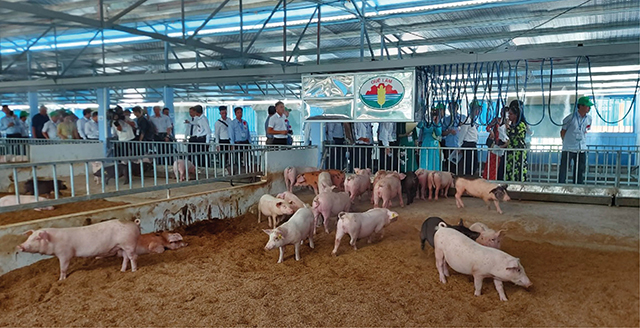
Bio-safe breeding is the optimal solution to overcome the pandemic, heading towards sustainable production
Safe breeding
The fact that Que Lam Group Joint Stock Company (Que Lam Group) was issued the investment license of the Project by the Thua Thien Hue Provincial People’s Committee at Phong Thu Commune, Phong Dien District not only becomes a sustainable solution for farmer households and family farm breeding but also heads towards the model of breeding in large farms, and industrial breeding in the provincial area.
The complex was built on the area of 15 hectares with the total capital investment of 700 billion VND, being implemented into each phase and items. It is expected that the whole project of the 4F complex will be completed in 2021.
Mr. Nguyen Hong Lam, Chairman of the board of directors of Que Lam Group shared that the 4F Complex (Farm – Food – Feed – Fertilizer) was the Project that actualized the definition of “circular economy in agriculture”. The construction of the Project not only serves the production and breeding operations of the Group but more importantly, the Group also wants the 4F complex to become a role model about organic breeding so that the farmer households and others can learn and scale-up this model.
The Complex includes the investment items such as the factory producing bio-products with the function of producing probiotics and microbial products with Japan’s leading advanced technology with a capacity of 50 thousand tons per year. The plant is constructed on the area of 2.5 hectares, serving organic and biological breeding and farming, together with reusing agricultural by-products into microbial organic fertilizers to protect the environment.
The non-chemical organic feed manufacturer which has the designed capacity of 100.000 tons per year, built on the area of 3.5 hectares serves a bio-safe, organic, and effective breeding chain. The farmers are responsible for being proactive in production and providing input materials.
The bio-safe organic pig farm is the first completed item of the Project with the area of 2 hectares, including 3 rows of pigsty (3.600 m2/ pigsty row). The farm is applied automation in the stage of breeding, improved naturally open pigsties that are warm in the winter and cool in the summer. Three fourths of the total area of each pigsty is set up with biological pads and automatic troughs.
Up to now, Que Lam Group has finished and put into operation the farm with the scale of 8 – 10.000 market hogs and breeding sows serving repopulation, developing the flocks of pig for Que Lam’s farm and for farmer households who are in partnership with the Group.
With the pigsty rows raising hundreds of breeding sows per year, it is estimated to produce 3.000 – 3.500 piglets that are free of diseases, meeting the Vietnam standard to repopulation and develop the flocks. With 2 rows of market hogs, each row has 60 pigsties (60m2/one) that can raise 8.000 – 10.000 market hogs per year, the output is estimated at 800 – 1.000 tons of organic and high-quality pork to serve the market.
The factory producing microbial organic fertilizers with its capacity of 100.000 tons per year collects and processes the whole by-products in the 15-hectare complex of the Project, as well as collects the by-products in agricultural production of surrounding areas to produce organic fertilizers.
The basic difference between bio-safe organic pig farm of Que Lam and other models is that the pig farm is applied with the world’s most modern microbiological technology in bio-safe organic breeding and protecting the environment; using microbial products in food and drink, enhancing the efficiency of food use, improving the immunity and fighting some pathogenic microorganisms in livestock; using microbial products to supplement biological pads.
Model of circular economy
Mr. Nguyen Van Phuong, Member of the Provincial Party Committee, Vice Chairman of the Provincial People’s Committee assessed that together with enhancing the restructure of agricultural production, the province identified that Que Lam Group’s Project is one of the key ones in the field of agriculture and rural development in the area. The Project has led the way in pioneering and innovative thinking in agricultural production, especially handling the difficult problem in organic agricultural production and pig breeding in the face of the disease situation. From the first model of this Project, the model of organic breeding and farming in value chains is now expanding in many localities.
Mr. Nguyen Xuan Cuong, Minister of Agriculture and Rural Development affirmed that this is a key Project playing an important significance to the agriculture sector.
With the Project of 4F Complex, the minister of Agriculture and Rural Development said that this is a model of sustainable development for Vietnam agriculture in the coming time. “Through the project of Que Lam Group, we will build up organic agriculture, a model of circular economy in agriculture which leaves nothing; no one is left behind. This project reaches 3 goals including ensuring the greenest environment, ensuring the highest economic factor and ensuring the humanization that all participants can get the satisfactory income of their effort,” shared Minister Nguyen Xuan Cuong.
Story and photo: Ha Nguyen